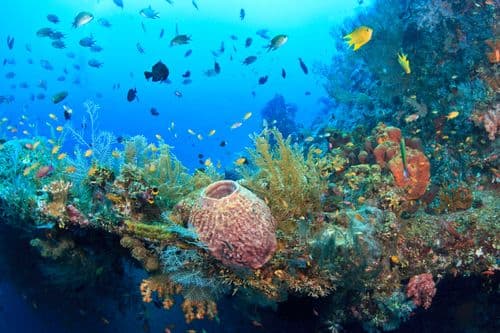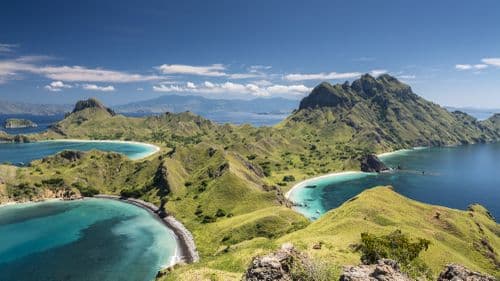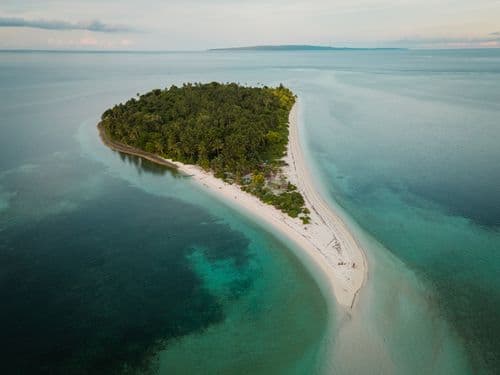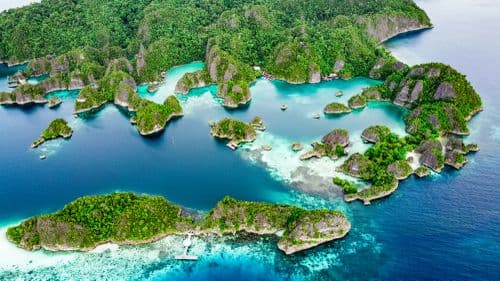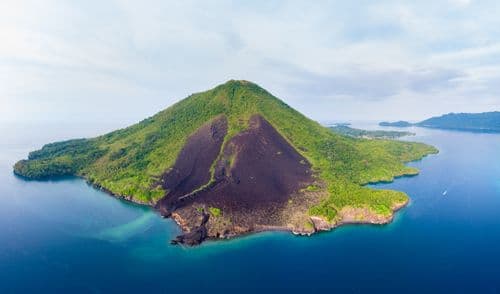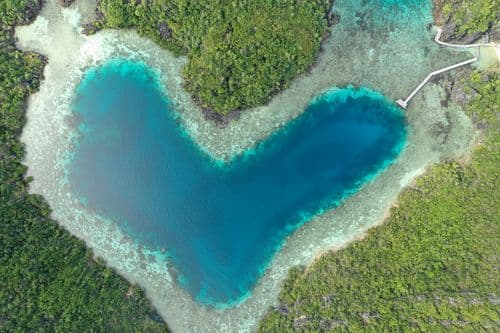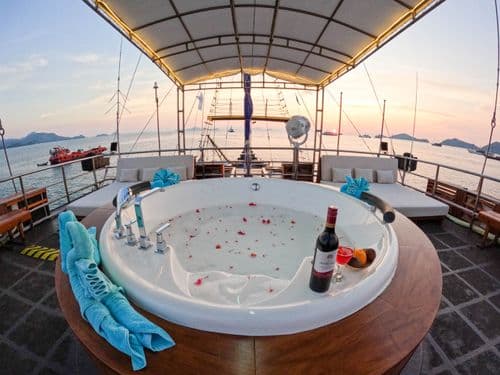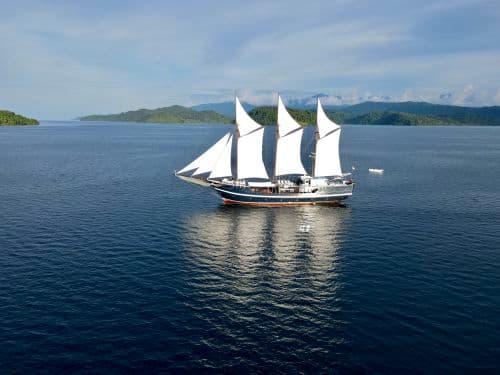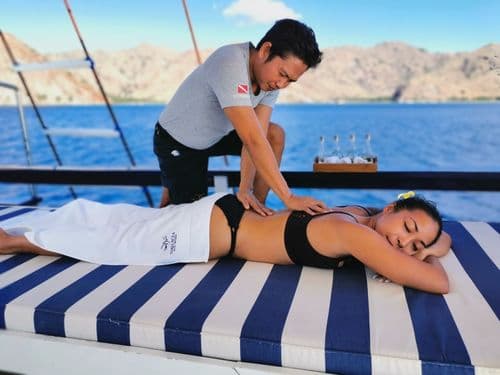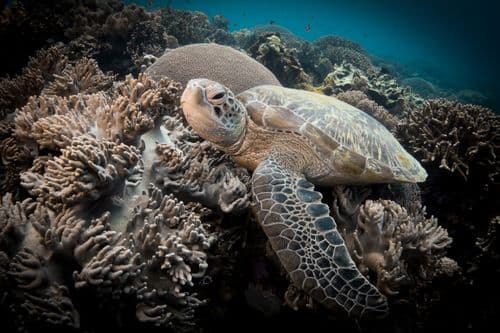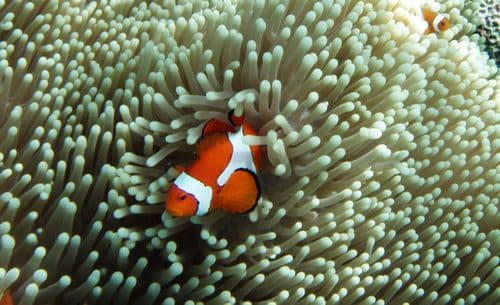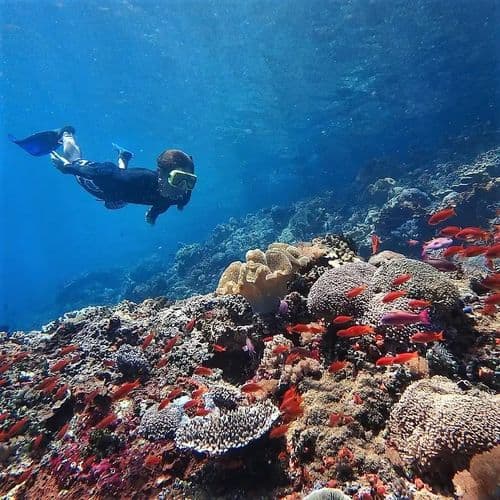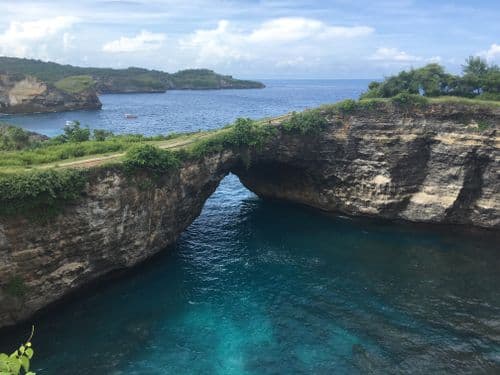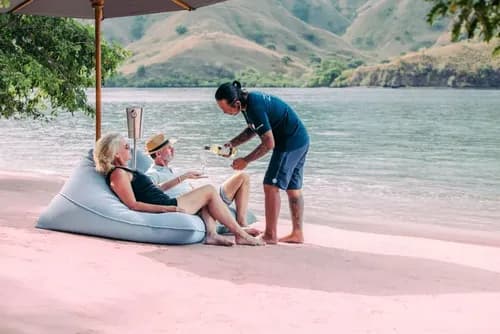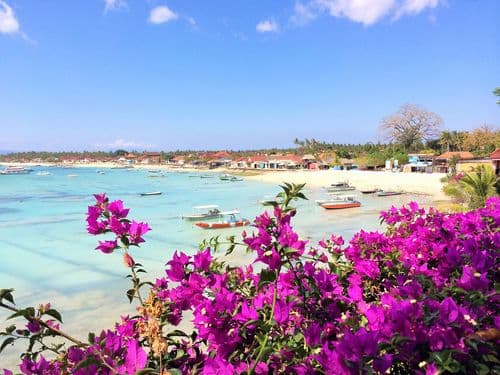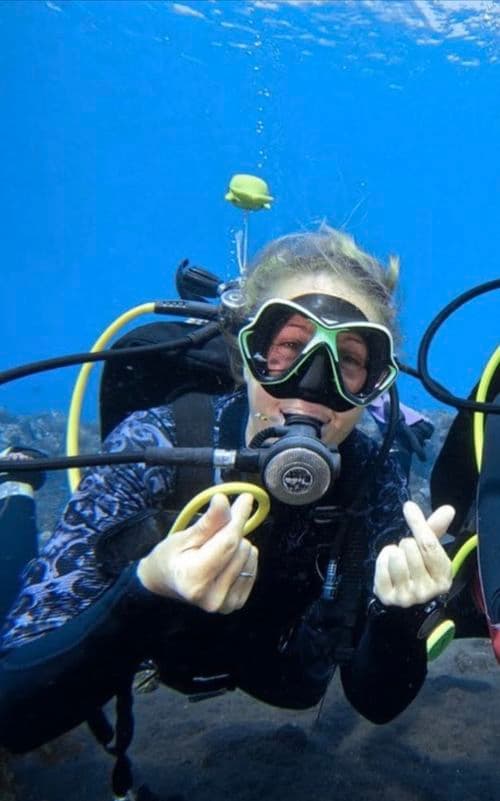
All of Raja Ampat
A 12-day journey through the heart of Indonesia's marine paradise on board Dewi Nusantara
Length
12 Days
Ship category
Luxury
Ship type
Small Ship
Capacity
18 Passengers
All of Raja Ampat
11 Reviews
Trip highlights
Dive the most fish-populated dive site on the planet
Experience an incredible seamount attracting a wealth of marine life
Marvel at one of Raja Ampat’s most stunning shallow reefs
Hunt for critters in the fascinating night waters around the Cendana Pearl Farm
The DiveIndonesia experience
Explore the entirety of Raja Ampat, covering its most iconic and remote dive sites over 12 days.
Enjoy the opulent setting of Dewi Nusantara, with spacious cabins, gourmet dining, and exceptional service.
Perfect for underwater photographers, with a wide range of dive environments from shallow reefs to deep seamounts.
Led by an experienced dive team, ensuring safe, well-organized dives with detailed briefings and local insights.
Set sail from Sorong on a 12-day journey aboard the luxurious Dewi Nusantara, exploring the entirety of Raja Ampat, Indonesia’s crown jewel of marine biodiversity. This round-trip adventure, starting and ending in Sorong, is perfect for divers eager to explore the Coral Triangle’s most iconic sites. Across 12 days, you’ll enjoy up to 33 dives, with opportunities to encounter everything from vibrant coral gardens at Melissa’s Garden to the thrilling pelagic action at Cape Kri.
Dewi Nusantara’s expert crew will guide you through a diverse range of underwater environments, from the crystal-clear waters of Mioskon to the critter-rich night dives of Aljui Bay. Non-divers are also catered to with activities like snorkeling, beach excursions, and cultural visits, ensuring a fulfilling experience for everyone on board.
Your ship: Dewi Nusantara



We highly recommend the Dewi Nusantara for those seeking the pinnacle of luxury and adventure in Indonesian waters. This 58-meter, three-masted schooner was meticulously crafted with divers in mind, combining traditional Indonesian design with modern amenities to create a liveaboard experience unlike any other. Since her launch in 2008, Dewi Nusantara has become an icon in the world of luxury liveaboard diving.
When you board Dewi Nusantara, you'll be entering a world of elegance and top-notch service. The ship’s spacious cabins are tastefully designed, each one offering a personal sanctuary … Read more about Dewi Nusantara
Cabins


Amenities
Transfers to and from ship
Bar
Observation Deck
Wetsuits (can be rented)
Snorkel gear (free of charge)
Kayaks on board
All meals
Beer+wine with dinner
Air conditioning & private bathroom
Single travellers can share cabin
Water, Coffee, Tea & fresh juices
Restaurant
Food & Drinks
Onboard dining is an experience in itself. The Dewi Nusantara’s chefs prepare a diverse array of dishes, blending local Indonesian flavors with international cuisine. The 1st breakfast is a grazing breakfast buffet-style. After the 1st dive, guest have the 2nd breakfast, they can order from a list of a variety of dishes. Meals for lunch are served buffet-style. Elegant dinner has a waiter service (but no dress code). Snacks and soft drinks are available at any time of day and night. Most special dietary requirement are easily accommodated
Map
Itinerary
Your itinerary below may vary, depending on the weather, wildlife breeding, and local conditions.
Day 1
Sorong



Guests will arrive at Sorong airport and be met by our arrivals team and taken by car to Sorong Harbour and then by tender to the ship. Guests will enjoy a cold towel and a refreshing welcome drink before being shown to allocated cabins. After that, the dive team will help guests unpack and store their dive equipment, assemble tanks, and deal with any requests or queries.
Day 2
Mios Kon



Mioskon and Kri are just two of many islands offshore from the Gam and Waigeo shorelines in the Dampier Strait. The seascape around these islands features some of the most spectacular scuba diving anywhere on the planet. Magnificent coral gardens, thrilling seamounts, big fish encounters, and amazing critter activity are the order of the day here in this marine paradise.
The sheer quality and number of dive sites here place this spot at the top of every coral and fish spotter’s wish list. The Strait’s channels and seamounts form a complicated marinescape, pushing and pulling currents in a variety of directions. These strong tidal flows carry nutrients from deep water to feed spectacular reefs.
Colourful corals and prolific concentrations of schooling fish make this collection of islands and waterways a place not to be missed on any cruise to this astonishing region of eastern Indonesia.
Day 3
Yangeffo



Scuba diving around Yangeffoo is very popular with visiting divers. The coral-covered ridges, reefs, and seamounts around the island create a number of excellent and exciting dive sites.
One of the most popular seamounts to dive at Yangeffoo is called Mayhem, close to the west side of the island. This is a current-washed, shallow coral reef for experienced divers seeking a little more adventure. Another submerged reef formation, Batu Dalam, is just south-west of Mayhem. Its shallowest depth is 10 metres, and it could prove to be interesting with some exploration and effort.
Inside the waterway separating Yangello from Gam Island, there are a number of ridges that extend into the channel. Extensive mangrove forests grow just above the corals at the shoreline, providing excellent opportunities to shoot under/over split images when the conditions are calm, clear, and still. Some of the soft corals growing in the waterway are bright pink or purple in colour, and these too make fabulous photo subjects.
Day 4
Waigeo



Despite the fact that the Wofoh Islands have a limited number of dive sites, they remain a popular destination for visiting yachts. With easy anchorages, pristine reefs, and sublime beaches, it is not difficult to see why.
The sites at Wofoh are concentrated around the southern tip of the islands; both are excellent and can be combined into a single dive if needed.
Firstly, there is the dramatic wall under the westfacing cliffs. This drops into the deep and is covered with small indents and ledges that teem with marine life. The reef at the southern end that extends away from the wall is the second named area. The topography here is a nicely sloping reef covered with black coral bushes.
Extra exploration around the reefs around the tip of the north island could also turn up some interesting areas for divers to enjoy around this pretty location.
Day 5
Waigeo



Diving at Aljui is quite different from other locations in Raja Ampat; it is geared much more towards smaller critters than huge schools of fish and vast coral fields. The edges of the islands in the bay drop very steeply along sloping reefs and walls. Different species of pygmy seahorses make their lifelong homes on the large fan corals that sprout from the steep reefs. In addition, nudibranchs of all types are easy to find around the slopes, ledges, and reefs. One of Raja Ampat’s premier night dives is centred around the three piers at the Cendana Pearl Farm.
There is the main pier, where most of the farm’s operations are carried out; and two more a little further down the coast. The bottom topography and terrain are different from Aljui’s other sites; it is much flatter with a lot more sand, rubble, and gravel. Several excellent critter hunting areas are easy to find here, with plenty of fascinating subjects on offer, including sightings of wobbegong and the endemic walking epaulette shark.
Day 6
Fam Islands



Lying just under 15 nautical miles west of Arborek Island, the Penemu Group is a big favourite with visiting yachts. With numerous exciting land and watersports activities, this island collection has a lot to offer. Penemu’s varied dive sites all feature dazzling, colourful reefs teeming with marine life. There are awesome offshore ridges and seamounts, exciting drift dives, and one of the most talked about and photographed reefs in Indonesia: the mesmerising shallow corals of Melissa’s Garden.
As well as diving Penemu’s well-known sites, there is a good deal of scope for open-water exploration too. The deep seamounts, a few nautical miles to the west of the islands, give marine adventurers the chance to make their own discoveries and dive where few have ever dived before.
An added attraction at Penemu is a beautifully constructed walkway that takes visitors up to the peaks of the karst islands in the lagoon. This affords spectacular views over the seascape.
Day 7
Misool



The large island of Daram marks the easternmost boundary of the Misool region. The vast majority of the dive sites are not located around the island itself, but rather a short distance to the north-west.
They are undoubtedly some of the most astonishing and colourful in the entire area. Small collections of karst islets, located along the eastern end of a long island line that extends away from the east side of Misool, are the focal point for most of the site. Many of them boast incredibly abundant coral reefs and jaw-dropping topography.
They are also home to so much marine life that, at times, it defies description. The anchorages and sites are vulnerable to adverse sea and weather conditions due to their remote location. However, if the weather and sea conditions are favourable, the diving here is some of the very best that Raja Ampat has to offer. In addition, there are numerous opportunities to find many more new sites around these iconic rocky islands and ridges.
Day 8
Misool



The Wayil dive sites are mostly clustered around the western end of Wayilbatan Island. Comprising multi-peaked seamounts, karst island ridges, and exciting passages, they all feature abundant coral growth and a wealth of both pelagic and reefdwelling marine life. At Wayil, there is something for every level of diver.
These include easy and pretty reef sites, majestic open-water seamounts, and gentle drift dives that flow down some of the most otherworldly marine seascapes imaginable.
One of the most popular sites is “The Four Kings.” This incredible underwater experience takes place in open water, west of the anchorages, where an astonishing four-peaked seamount rises from the deep sea floor. This massive rocky marine structure acts as a magnet for all manner of marine life, large and small.
Day 9
Misool



The large island of Jef Pele, as well as the nearby Lili and Kepotsol groups, do not suffer from the concentration of divers and yachts that now visit the anchorages and marine attractions further east. However, they do feature some excellent diving opportunities. The north-western edge of Jef Pele is home to Kaleidoscope Ridge, the anchorage’s signature site. This is a fine example of Raja Ampat’s underwater world, with a dizzying array of corals and marine life, both large and small. This impressive coral-covered ridge’s incredible underwater architecture combines with a deeper seamount, attracting some of the larger animals that inhabit the abundant reefs and seas of the Misool region. Jef Pele’s complex coastline, as well as the numerous offshore islands further south, allow for more dive site exploration.
The sites at Lili and Kepotsol, just under two nautical miles north of the Jef Pele shoreline, share the same amazing marine life and coral characteristics as those around the more well-known anchorages. The scope for new discoveries is considerable, especially in the Kofani group, situated between Lili and Kepotsol.
Day 10
Misool



The dive sites in and around Fiabacet and Boo are quite honestly some of the very finest that Raja Ampat, Indonesia, or even the planet has to offer. The south side’s deep ocean floor rises to a marine topography that features a labyrinth of interconnected ridges and seamounts. These act as filters for the nutrient-rich currents flowing up and over the complex seascape, causing the vibrant reefs to explode in a riot of colour and form.
The quality of the numerous sites is incredible. The dives showcase some of the most impressive numbers of schooling fish, swarms of small reef fish, and dazzlingly colourful corals anywhere. At times, the dense clouds of schooling fish obscure the larger predators patrolling behind them. Visiting divers frequently spot grey, white-tip, and black-tip reef sharks, as well as many other powerful predators such as dog-tooth tunas, Spanish mackerel, giant trevally, and acrobatic mobula rays, scything through this massive feast of baitfish.
Karst limestone rocks, as well as the corners and coasts of the larger islands of Boo and Kalig, serve as the focal points for most of the sites. Currents and upwellings from the Ceram Sea to the south wash over these areas, which bring nutrients up from deeper water, sustaining the topographic reefs and marine life in the area.
Day 11
Batanta



The southern side of Batanta does not have the picture-perfect panoramas that are normally associated with Raja Ampat, but it does have some of the finest dive sites in the region for searching out weird and wonderful critters. Most underwater exploration of this area has concentrated along the southern shores of Batanta Island at its south-western end rather than further up the strait or along the coastline of Salawati on the other side. However, from time to time, discoveries of both new dive sites and rare and elusive marine creatures are often made. These sites are all centred around the numerous bays and coral reefs formed at their extremities. In the bays, the seabed consists of sand, gravel, and rubble dotted with coral heads. Narrow, dark-sand beaches border the coastline.
The shorelines of both Batanta and Salawati rise up to high forests, which often get a good deal of rainfall that flows down numerous watercourses that drain into the channel. The freshwater then mixes with the saltwater counter-currents that wash over the dive sites. These naturally occurring conditions combine to complete the criteria required for creating stellar critter dive sites, making the Sagewin Strait and, in particular, south-west Batanta one of Raja Ampat’s most popular locations for underwater photographers to enjoy
Day 12
Sorong



Guests depart in the morning – guests will be transferred to the airport.
Dates & Prices
When do you want to travel?
From
Until
Info
Availability
Price
28
Dec
2024
8
Jan
2025
From
USD 6,383
USD 7,979
28
Dec
2024
8
Jan
2025
From
USD 6,383
USD 7,979
16
Jan
2025
27
Jan
2025
From
USD 8,459
16
Jan
2025
27
Jan
2025
From
USD 8,459
28
Jan
2025
8
Feb
2025
- 20% Last Minute Special
From
USD 6,767
USD 8,459
28
Jan
2025
8
Feb
2025
20% Last Minute Special
From
USD 6,767
USD 8,459
9
Feb
2025
20
Feb
2025
Almost full
From
USD 8,459
9
Feb
2025
20
Feb
2025
Almost full
From
USD 8,459
21
Feb
2025
4
Mar
2025
From
USD 8,459
21
Feb
2025
4
Mar
2025
From
USD 8,459
21
May
2025
1
Jun
2025
From
USD 8,459
21
May
2025
1
Jun
2025
From
USD 8,459
9
Sep
2025
20
Sep
2025
From
USD 8,459
9
Sep
2025
20
Sep
2025
From
USD 8,459
21
Sep
2025
2
Oct
2025
From
USD 8,459
21
Sep
2025
2
Oct
2025
From
USD 8,459
20
Nov
2025
1
Dec
2025
From
USD 8,459
20
Nov
2025
1
Dec
2025
From
USD 8,459
2
Dec
2025
13
Dec
2025
From
USD 8,459
2
Dec
2025
13
Dec
2025
From
USD 8,459
Preferred date unavailable? Contact us
Info
Single Cabin Supplement
When booking online, you can choose the option to "Upgrade to single occupancy". This will guarantee you the whole cabin to yourself, for an additional fee. If you don't select this option, then another traveler of the same sex might be placed into the same cabin with you.
What's included
all meals
snacks
local beer, a glass of wine with dinner and all soft beverages
transfer to & from the airport
up to 4 dives per day
all air fills
weights and weight belts
dive instructors/masters
What's not included
pre or post cruise hotels
domestic & international flights
dive gear rental
nitrox fills
alcoholic beverages (other than as mentioned above)
boatique items
park and harbour fees ($335.00)
fuel surcharge ($330.00)
gratuity for the crew
dive courses
currency surcharge & all taxes & other costs imposed by local or national government
Reviews
Worth Knowing
Nitrox fills of up to 32% are usually available to all certified Nitrox divers for an additional charge.
For safety reasons, all guests will be given a complimentary SMB, a whistle and a Nautilus Lifeline (marine GPS) for use while diving.
Acceptable payment methods include US Dollars, Euros, local currency, or credit cards (Visa or Master Card; they do not accept American Express).
There are no corkage or bottle charges imposed for guests who choose to bring their favorite bottle of wine or spirits on board.
All services purchased on board are subject to local taxes at the prevailing rate at the date of your Cruise.
It is required by Indonesia law that you must have current diving and medical evacuation insurance to board.
FAQs
What are the different levels of dive certifications required for diving in Indonesia?
Diving in Indonesia offers a spectacular array of underwater experiences, catering to both novice and experienced divers. Here's a breakdown of the different dive certification levels you might need:
- Open Water Diver (OWD): This is the entry-level certification that allows you to dive up to 18 meters (60 feet) under the supervision of a dive professional. Ideal for exploring many of Indonesia’s stunning reefs and beginner-friendly dive sites.
- Advanced Open Water Diver (AOWD): Recommended for those looking to extend their diving skills and dive deeper, up to 30 meters (100 feet). This certification opens up more challenging dive sites in Indonesia, including some of the more famous dive spots in Komodo National Park and Raja Ampat.
- Rescue Diver: This certification is for those wanting to improve their safety and emergency response skills. It’s highly recommended for divers looking to undertake more adventurous dives.
- Divemaster: The first professional level, allowing you to lead certified divers. This is perfect for those looking to make a career out of diving or wanting to gain a deep understanding of dive planning and marine environments.
Where can I obtain dive certifications in Indonesia?
Indonesia is home to numerous world-class dive schools and resorts offering a range of certification courses. Here are some top recommendations:
- Bali: Renowned for its excellent dive training facilities, Bali offers everything from Open Water to Divemaster courses. Popular spots include Padang Bai and Amed.
- Gili Islands: Known for vibrant marine life and clear waters, the Gili Islands are a fantastic place to get certified. Many dive centers here offer courses in multiple languages.
- Komodo: For those already holding an Open Water certification, Komodo offers advanced training opportunities with its thrilling currents and diverse dive sites.
- Raja Ampat: While more remote, Raja Ampat provides unparalleled diving experiences and advanced training in one of the world's most biodiverse marine environments.
Do I need an advanced certification to dive in Indonesia?
While an Open Water certification is sufficient for many dive sites in Indonesia, an Advanced Open Water certification is highly recommended. This allows you to dive deeper and access more challenging and rewarding dive sites. It’s especially beneficial for exploring areas with stronger currents or deeper reefs.
What should I consider when choosing a dive school in Indonesia? When selecting a dive school, consider the following:
- Certification Agency: Ensure the school is affiliated with a recognized certification agency like PADI or SSI.
- Instructor Experience: Look for experienced instructors with a good track record of safety and student success.
- Class Sizes: Smaller class sizes often mean more personalized attention and a better learning experience.
- Equipment Quality: Check that the school uses well-maintained and up-to-date diving equipment.
- Reviews and Recommendations: Read reviews and seek recommendations from fellow divers to ensure a reputable and enjoyable learning experience.
Can I get certified before my trip to Indonesia?
Absolutely! Many divers prefer to complete their theory and pool sessions at home and finish their open water dives in the crystal-clear waters of Indonesia. This option, known as a referral course, allows you to maximize your vacation time enjoying the incredible marine life.
With a range of certification levels and top-notch dive schools, Indonesia is an ideal destination for divers of all abilities. Whether you’re just starting out or looking to advance your skills, the underwater wonders of Indonesia await you.
For more detailed advice and personalized recommendations, feel free to contact us! Happy diving!
How much is my down payment, what's the cancellation policy?
Please see our complete Terms and Conditions where you will find our detailed payment and cancellation policies.
Do I Need Dive Insurance for My Indonesia Liveaboard Trip?
Diving in Indonesia offers unparalleled underwater experiences, from the vibrant reefs of Raja Ampat to the thrilling currents of Komodo. However, with these adventures comes the need for proper protection. Dive insurance is essential for any diver exploring Indonesia’s waters, ensuring peace of mind and safety in case of emergencies. Here’s everything you need to know about dive insurance, why it’s important, what it should cover, and our recommended provider.
Why Dive Insurance is Important
Diving is an adventurous activity that, while generally safe, carries inherent risks. Unexpected incidents such as decompression sickness, marine life injuries, or equipment failures can occur. Dive insurance provides coverage for medical treatments, emergency evacuations, and other dive-related incidents that could otherwise result in significant expenses. Without insurance, divers might face substantial out-of-pocket costs for medical care, hyperbaric chamber treatments, or emergency evacuations, especially in remote locations.
What Dive Insurance Should Cover
When selecting dive insurance, it’s crucial to ensure that your policy provides comprehensive coverage tailored to diving activities. Here are the key elements your dive insurance should include:
- Emergency Medical Expenses: Coverage for treatments related to diving injuries, including decompression sickness and other dive-related medical conditions.
- Hyperbaric Chamber Treatments: Costs for hyperbaric chamber use, essential for treating decompression sickness.
- Emergency Evacuation and Repatriation: Coverage for air or sea evacuation to the nearest appropriate medical facility and transportation back home if necessary.
- Dive Equipment Loss or Damage: Protection for your valuable diving gear in case of loss, theft, or damage.
- Trip Cancellation or Interruption: Reimbursement for prepaid dive trips or courses if you need to cancel or cut your trip short due to unforeseen circumstances.
- Personal Liability: Coverage for legal liability in case you accidentally cause injury to others or damage property while diving.
Recommended Dive Insurance Provider
At DiveIndonesia, we only work with trusted insurance providers to ensure our clients receive the best coverage. Our recommended provider is DiveAssure, a leading specialist in dive insurance. DiveAssure offers comprehensive policies specifically designed for divers, providing extensive coverage and peace of mind.
Why Choose DiveAssure?
- Specialized Coverage: DiveAssure’s policies are tailored to meet the unique needs of divers, offering extensive coverage for diving-related incidents.
- Global Network: Access to a worldwide network of hyperbaric chambers and medical facilities experienced in treating dive injuries.
- 24/7 Assistance: Immediate support and assistance available around the clock, ensuring help is just a call away.
- Flexible Plans: Various plans to suit different diving activities, from recreational diving to technical diving and liveaboard trips.
- Quick Claims Process: Efficient and hassle-free claims process, ensuring you receive the support you need promptly.
Practical Tips for Choosing Dive Insurance
- Assess Your Diving Activities: Consider the types of diving you’ll be doing (recreational, technical, liveaboard) and choose a plan that covers these activities.
- Read the Fine Print: Ensure you understand what is and isn’t covered by the policy, including any exclusions or limitations.
- Check the Provider’s Reputation: Opt for reputable providers with positive reviews and a strong track record in handling dive-related claims.
- Compare Plans: Evaluate different plans and providers to find the one that best meets your needs and budget.
- Don’t Skimp on Coverage: While it might be tempting to choose the cheapest option, ensure your policy offers comprehensive coverage for all potential risks.
Dive insurance is a critical aspect of planning your diving trip to Indonesia. It provides essential protection and ensures that you can enjoy your underwater adventures with confidence. By choosing a comprehensive policy from a trusted provider like DiveAssure, you can dive into Indonesia’s breathtaking waters knowing you’re covered for any eventuality. Contact us for any further questions. Safe diving!
What are the passport and visa requirements for Indonesia?
Planning your dive adventure in Indonesia starts with understanding the passport and visa requirements. Here’s everything you need to know:
1. Do I Need a Passport to Travel to Indonesia? Yes, all travelers entering Indonesia must have a valid passport. Your passport must be valid for at least six months from the date of your entry into Indonesia.
2. Do I Need a Visa to Enter Indonesia? Visa requirements depend on your nationality and the length of your stay:
- Visa-Free Entry: Citizens of many countries can enter Indonesia without a visa for short stays (up to 30 days) for tourism purposes. This visa-free entry cannot be extended or converted into another type of visa.
- Visa on Arrival (VoA): If you plan to stay for more than 30 days, you can obtain a Visa on Arrival at certain entry points. The VoA is valid for 30 days and can be extended once for an additional 30 days.
- Visit Visa: For longer stays or other purposes (business, social, etc.), you may need to apply for a visit visa at an Indonesian embassy or consulate before your trip. This visa typically allows for a stay of up to 60 days and can be extended.
3. How Do I Apply for a Visa on Arrival? To obtain a Visa on Arrival:
- Ensure your passport is valid for at least six months from the date of entry.
- Pay the visa fee (currently USD 35) at the designated counter before immigration.
- Provide a return or onward ticket and proof of sufficient funds for your stay.
- Fill out the necessary forms provided at the entry point.
4. Which Countries are Eligible for Visa-Free Entry and Visa on Arrival? The list of eligible countries can change, so it’s best to check with the Indonesian embassy or consulate in your country or visit the official Indonesian immigration website. Generally, most ASEAN countries, the United States, the European Union, and several other nations are eligible.
5. What Should I Do if My Passport Expires While I am in Indonesia? You must exit Indonesia using the same passport you used to enter. If your passport is replaced while you are in Indonesia, you must apply for an exit permit (known as a “special pass”) from the local immigration office before you leave the country (Travel.state.gov).
6. Are There Any Health Requirements or Restrictions? Indonesia does not have HIV/AIDS entry restrictions for visitors or foreign residents. However, health screening may be conducted for incoming passengers during outbreaks of pandemic illnesses (Travel.state.gov). (Travel.state.gov)
7. Can I Extend My Stay in Indonesia? Yes, if you entered on a Visa on Arrival, you can extend it once for an additional 30 days. For other visas, you may need to visit an immigration office to apply for an extension. Make sure to apply for an extension before your current visa expires to avoid fines or penalties.
8. What Are the Entry Requirements for Children? Children traveling with parents must have their own passport. If only one parent is traveling with the child, a consent letter from the other parent may be required
9. What Are the Requirements for Business Travelers? Business travelers may need a specific business visa, which allows for multiple entries and stays of up to 60 days. It’s advisable to contact the Indonesian embassy or consulate for the most accurate and up-to-date information.
10. Where Can I Find More Information? For the latest updates and detailed information, visit the Indonesian Immigration website or contact your nearest Indonesian embassy or consulate.

What should I pack for a Liveaboard Dive Trip?
Packing for a liveaboard dive trip in Indonesia can be a thrilling yet daunting task. With dozens of liveaboard trips under our belts, we have honed the art of packing to perfection. Whether you're a seasoned diver or embarking on your first underwater adventure, our comprehensive packing list will ensure you're fully prepared. Let's dive in!
Essentials for Your Liveaboard Dive Trip
Dive Gear
- Mask, Snorkel, and Fins: Your mask should fit comfortably, and we recommend bringing your own snorkel and fins to ensure they meet your personal preferences. The waters in Indonesia are warm, with temperatures ranging from 27°C to 30°C (81°F to 86°F), making full-foot fins an excellent choice.
- Wetsuit: A 3mm wetsuit is usually sufficient for Indonesian waters, but if you're prone to getting cold, consider a 5mm suit. For comparison, other destinations like the Maldives might require thicker suits due to cooler temperatures.
- Buoyancy Control Device (BCD) and Regulator A comfortable BCD and a well-maintained regulator are crucial. It's always a good idea to bring your own gear to avoid any surprises. We've found that relying on rental gear can sometimes lead to unexpected issues.
- Dive Computer: Essential for monitoring your dive profiles and staying safe. Ensure your computer is set to the correct time zone and has a fresh battery.
- Underwater Camera and Housing: Indonesia's marine life is spectacular, so capturing it with a quality underwater camera is a must. Don't forget spare batteries and memory cards.
- Dive Torch and Backup Light: Night dives are a highlight in Indonesia, with visibility ranging from 15 to 30 meters (50 to 100 feet). A primary torch and a backup are essential for safety.
- Surface Marker Buoy (SMB): Indispensable for safety, especially when diving in areas with strong currents.
- Reef-Safe Sunscreen: Protect your skin and the environment with reef-safe sunscreen. Indonesia's sun can be intense, so reapply frequently.
Clothing and Personal Items
- Lightweight, Quick-Dry Clothing: Pack breathable, quick-drying clothing for the warm tropical climate. Shorts, t-shirts, and swimsuits are essentials.
- Sun Protection: A wide-brimmed hat, sunglasses, and a sarong or light cover-up will help protect you from the sun between dives.
- Casual Evening Wear: Comfortable, casual clothing for relaxing on deck in the evenings. Lightweight long sleeves and pants can also protect against mosquitoes.
- Personal Hygiene Items: Pack biodegradable soap and shampoo to minimize your environmental impact. Don't forget your toothbrush, toothpaste, and other personal items.
- Motion Sickness Medication: Even if you don't usually get seasick, it's wise to bring some motion sickness medication just in case. The waters around Indonesia can be calm, but conditions can change.
- First Aid Kit: A small kit with band-aids, antiseptic cream, and any personal medications you might need.
Travel Documents and Miscellaneous
- Passport and Visa: Ensure your passport is valid for at least six months beyond your trip. Check the visa requirements for Indonesia and have all necessary documents.
- Travel Insurance and Dive Insurance: Travel insurance is essential for peace of mind, covering both health and dive-related incidents. Most liveaboards require dive insurance specifically, so make sure you have comprehensive coverage that includes diving.
- Certification Cards and Logbook: Bring your dive certification cards and logbook. It's always nice to log your dives and share experiences with fellow divers.
- Cash and Credit Cards: While most liveaboards accept credit cards, it's a good idea to bring some cash for tips and small purchases.
- Reusable Water Bottle Stay hydrated with your own reusable water bottle. Many liveaboards provide refill stations.
Special Tips for Non-Divers If you're accompanying a diver but don't plan to dive yourself, bring plenty of books, a good camera, and perhaps some snorkeling gear to enjoy the beautiful reefs from the surface. Indonesia offers incredible biodiversity, so there will be plenty to see and do.
Packing for a liveaboard dive trip doesn't have to be stressful. With our expert advice and comprehensive packing list, you'll be ready to embark on an unforgettable adventure in Indonesia. We are here to ensure you have the best experience possible, so don't hesitate to reach out with any questions or for further tips. Safe travels and happy diving!
What to Expect on a Liveaboard Trip in Indonesia?
Embarking on a liveaboard trip in Indonesia is a unique and exhilarating way to explore some of the world's most spectacular diving destinations. These floating dive resorts offer the perfect blend of adventure and relaxation, allowing you to dive multiple times a day, explore remote islands, and enjoy top-notch amenities. Here's an overview of what you can expect on a liveaboard trip in Indonesia.
Daily Schedules
A typical day on a liveaboard is well-structured yet flexible, ensuring you get the most out of your diving adventure while also having time to relax and enjoy the surroundings. Here’s what a day might look like:
- Early Morning: Start your day with a light breakfast and a pre-dive briefing. The first dive usually takes place early in the morning when marine life is most active.
- Mid-Morning: After your first dive, return to the boat for a hearty breakfast. There’s time to relax, review your dive photos, or bask in the sun before the second dive.
- Late Morning Dive: Head out for your second dive of the day, exploring another stunning site with unique underwater features.
- Lunch: Enjoy a delicious lunch prepared by the onboard chef, offering a mix of local and international cuisine.
- Afternoon Dive: After a brief rest, gear up for your third dive of the day. Some liveaboards offer optional land excursions to explore nearby islands.
- Evening: Return for a relaxing dinner and share stories with fellow divers. If conditions are right, you may have the opportunity for a night dive, encountering nocturnal marine creatures.
- Night: Wind down with a movie, star-gazing on the deck, or simply enjoying the serenity of being at sea.
Onboard Amenities
Liveaboards in Indonesia are designed to provide comfort and convenience, ensuring you have everything you need for an enjoyable trip. Here are some common amenities you can expect:
- Accommodation: Comfortable cabins with air conditioning, en suite bathrooms, and storage for personal belongings.
- Dining: Three meals a day plus snacks, catering to various dietary preferences. Fresh ingredients and a variety of dishes keep meals exciting.
- Lounge Areas: Indoor and outdoor lounge areas for relaxation, socializing, and enjoying the view.
- Dive Deck: Well-equipped dive deck with gear storage, rinse tanks, and camera stations.
- Recreational Facilities: Some liveaboards offer additional amenities such as kayaks, paddleboards, and onboard spas.
- Safety Equipment: Comprehensive safety gear including first aid kits, emergency oxygen, and life jackets.
Types of Dives
Indonesia's liveaboard trips offer a diverse range of diving experiences, catering to all levels of divers. Here are the types of dives you can expect:
- Reef Dives: Explore vibrant coral reefs teeming with marine life, from tiny nudibranchs to large pelagics.
- Drift Dives: Experience the thrill of drift diving in strong currents, gliding effortlessly over stunning underwater landscapes.
- Muck Dives: For macro enthusiasts, muck dives offer the chance to discover bizarre and fascinating critters in sandy or muddy environments.
- Night Dives: Discover the underwater world after dark, encountering nocturnal creatures and witnessing bioluminescence.
- Wreck Dives: Explore historic shipwrecks, home to a myriad of marine species and rich in history.
- Pelagic Dives: Dive in deep waters to see large pelagics such as manta rays, sharks, and schools of fish.
Practical Tips for Your Liveaboard Trip
- Pack Light but Smart: Bring essential dive gear, comfortable clothing, and personal items. Most liveaboards provide towels and basic toiletries.
- Stay Hydrated: Drink plenty of water throughout the day, especially after dives.
- Listen to Briefings: Pay attention to dive briefings and follow the crew's instructions to ensure a safe and enjoyable experience.
- Respect Marine Life: Practice responsible diving by not touching or disturbing marine life and adhering to eco-friendly practices.
A liveaboard trip in Indonesia is a remarkable way to immerse yourself in the underwater wonders of this diverse archipelago. With a blend of exciting dives, luxurious onboard amenities, and the chance to meet like-minded adventurers, it’s an experience you’ll cherish forever. Dive in and discover the magic of Indonesia’s underwater paradise! Contact us for any further questions.
All of Raja Ampat
5.0
(11)
From
USD 6,383
No dates selected
